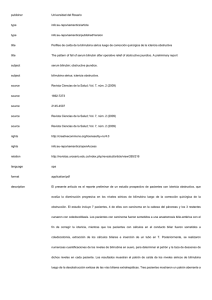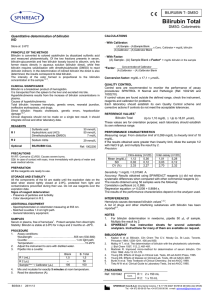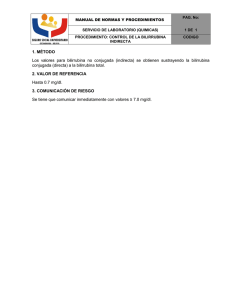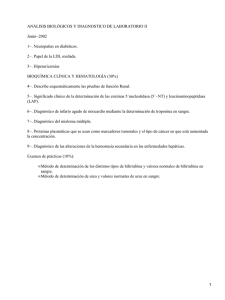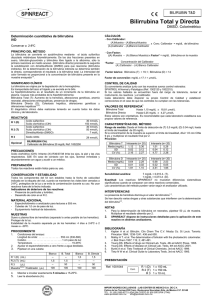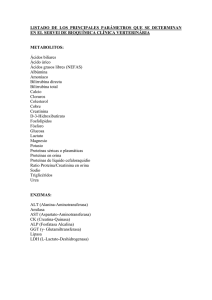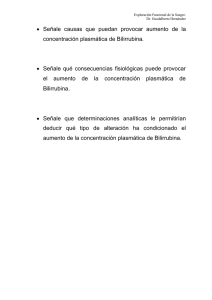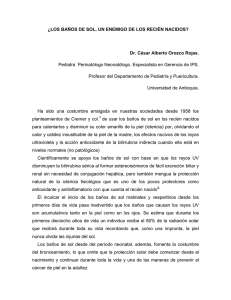Bilirrubina Total y Directa
Anuncio
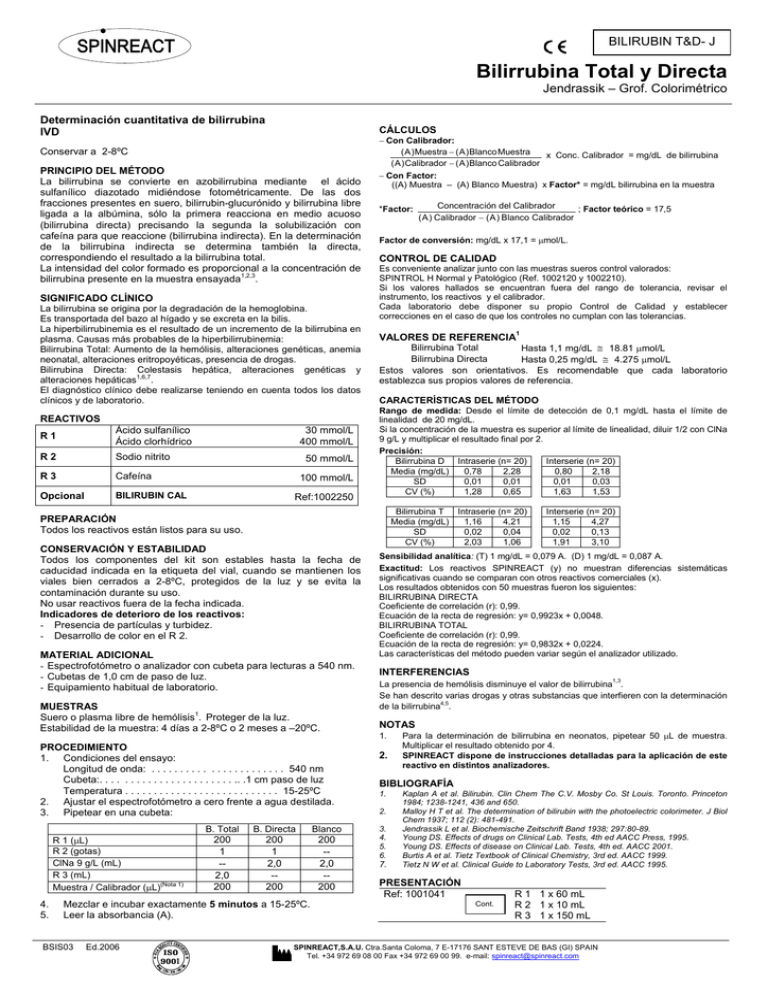
BILIRUBIN T&D- J Bilirrubina Total y Directa Jendrassik – Grof. Colorimétrico Determinación cuantitativa de bilirrubina IVD CÁLCULOS Conservar a 2-8ºC PRINCIPIO DEL MÉTODO La bilirrubina se convierte en azobilirrubina mediante el ácido sulfanílico diazotado midiéndose fotométricamente. De las dos fracciones presentes en suero, bilirrubin-glucurónido y bilirrubina libre ligada a la albúmina, sólo la primera reacciona en medio acuoso (bilirrubina directa) precisando la segunda la solubilización con cafeína para que reaccione (bilirrubina indirecta). En la determinación de la bilirrubina indirecta se determina también la directa, correspondiendo el resultado a la bilirrubina total. La intensidad del color formado es proporcional a la concentración de 1,2,3 bilirrubina presente en la muestra ensayada . SIGNIFICADO CLÍNICO La bilirrubina se origina por la degradación de la hemoglobina. Es transportada del bazo al hígado y se excreta en la bilis. La hiperbilirrubinemia es el resultado de un incremento de la bilirrubina en plasma. Causas más probables de la hiperbilirrubinemia: Bilirrubina Total: Aumento de la hemólisis, alteraciones genéticas, anemia neonatal, alteraciones eritropoyéticas, presencia de drogas. Bilirrubina Directa: Colestasis hepática, alteraciones genéticas y alteraciones hepáticas1,6,7. El diagnóstico clínico debe realizarse teniendo en cuenta todos los datos clínicos y de laboratorio. REACTIVOS R1 Ácido sulfanílico Ácido clorhídrico R2 Sodio nitrito R3 Cafeína Opcional BILIRUBIN CAL 30 mmol/L 400 mmol/L 50 mmol/L 100 mmol/L Ref:1002250 − Con Calibrador: ( A ) Muestra − ( A ) Blanco Muestra x Conc. Calibrador = mg/dL de bilirrubina ( A ) Calibrador − ( A ) Blanco Calibrador − Con Factor: ((A) Muestra – (A) Blanco Muestra) x Factor* = mg/dL bilirrubina en la muestra *Factor: Factor de conversión: mg/dL x 17,1 = μmol/L. CONTROL DE CALIDAD Es conveniente analizar junto con las muestras sueros control valorados: SPINTROL H Normal y Patológico (Ref. 1002120 y 1002210). Si los valores hallados se encuentran fuera del rango de tolerancia, revisar el instrumento, los reactivos y el calibrador. Cada laboratorio debe disponer su propio Control de Calidad y establecer correcciones en el caso de que los controles no cumplan con las tolerancias. 1 VALORES DE REFERENCIA Bilirrubina Total Hasta 1,1 mg/dL ≅ 18.81 μmol/L Bilirrubina Directa Hasta 0,25 mg/dL ≅ 4.275 μmol/L Estos valores son orientativos. Es recomendable que cada laboratorio establezca sus propios valores de referencia. CARACTERÍSTICAS DEL MÉTODO Rango de medida: Desde el límite de detección de 0,1 mg/dL hasta el límite de linealidad de 20 mg/dL. Si la concentración de la muestra es superior al límite de linealidad, diluir 1/2 con ClNa 9 g/L y multiplicar el resultado final por 2. Precisión: Bilirrubina D Intraserie (n= 20) Interserie (n= 20) Media (mg/dL) 0,78 2,28 0,80 2,18 SD 0,01 0,01 0,01 0,03 CV (%) 1,28 0,65 1,63 1,53 Bilirrubina T Intraserie (n= 20) Media (mg/dL) 1,16 4,21 SD 0,02 0,04 CV (%) 2,03 1,06 PREPARACIÓN Todos los reactivos están listos para su uso. CONSERVACIÓN Y ESTABILIDAD Todos los componentes del kit son estables hasta la fecha de caducidad indicada en la etiqueta del vial, cuando se mantienen los viales bien cerrados a 2-8ºC, protegidos de la luz y se evita la contaminación durante su uso. No usar reactivos fuera de la fecha indicada. Indicadores de deterioro de los reactivos: - Presencia de partículas y turbidez. - Desarrollo de color en el R 2. MATERIAL ADICIONAL - Espectrofotómetro o analizador con cubeta para lecturas a 540 nm. - Cubetas de 1,0 cm de paso de luz. - Equipamiento habitual de laboratorio. MUESTRAS 1 Suero o plasma libre de hemólisis . Proteger de la luz. Estabilidad de la muestra: 4 días a 2-8ºC o 2 meses a –20ºC. PROCEDIMIENTO 1. Condiciones del ensayo: Longitud de onda: . . . . . . . . . . . . . . . . . . . . . . . 540 nm Cubeta:. . . . . . . . . . . . . . . . . . . . . . . .. .1 cm paso de luz Temperatura . . . . . . . . . . . . . . . . . . . . . . . . . . . 15-25ºC 2. Ajustar el espectrofotómetro a cero frente a agua destilada. 3. Pipetear en una cubeta: R 1 (μL) R 2 (gotas) ClNa 9 g/L (mL) R 3 (mL) Muestra / Calibrador (μL)(Nota 1) 4. 5. B. Total B. Directa Blanco 200 1 -2,0 200 200 1 2,0 -200 200 -2,0 -200 Mezclar e incubar exactamente 5 minutos a 15-25ºC. Leer la absorbancia (A). BSIS03 Ed.2006 Concentrac ión del Calibrador ; Factor teórico = 17,5 ( A ) Calibrador − ( A ) Blanco Calibrador Interserie (n= 20) 1,15 4,27 0,02 0,13 1,91 3,10 Sensibilidad analítica: (T) 1 mg/dL = 0,079 A. (D) 1 mg/dL = 0,087 A. Exactitud: Los reactivos SPINREACT (y) no muestran diferencias sistemáticas significativas cuando se comparan con otros reactivos comerciales (x). Los resultados obtenidos con 50 muestras fueron los siguientes: BILIRRUBINA DIRECTA Coeficiente de correlación (r): 0,99. Ecuación de la recta de regresión: y= 0,9923x + 0,0048. BILIRRUBINA TOTAL Coeficiente de correlación (r): 0,99. Ecuación de la recta de regresión: y= 0,9832x + 0,0224. Las características del método pueden variar según el analizador utilizado. INTERFERENCIAS La presencia de hemólisis disminuye el valor de bilirrubina1,3. Se han descrito varias drogas y otras substancias que interfieren con la determinación de la bilirrubina4,5. NOTAS 1. 2. Para la determinación de bilirrubina en neonatos, pipetear 50 μL de muestra. Multiplicar el resultado obtenido por 4. SPINREACT dispone de instrucciones detalladas para la aplicación de este reactivo en distintos analizadores. BIBLIOGRAFÍA 1. 2. 3. 4. 5. 6. 7. Kaplan A et al. Bilirubin. Clin Chem The C.V. Mosby Co. St Louis. Toronto. Princeton 1984; 1238-1241, 436 and 650. Malloy H T et al. The determination of bilirubin with the photoelectric colorimeter. J Biol Chem 1937; 112 (2): 481-491. Jendrassik L et al. Biochemische Zeitschrift Band 1938; 297:80-89. Young DS. Effects of drugs on Clinical Lab. Tests, 4th ed AACC Press, 1995. Young DS. Effects of disease on Clinical Lab. Tests, 4th ed. AACC 2001. Burtis A et al. Tietz Textbook of Clinical Chemistry, 3rd ed. AACC 1999. Tietz N W et al. Clinical Guide to Laboratory Tests, 3rd ed. AACC 1995. PRESENTACIÓN Ref: 1001041 Cont. R 1 1 x 60 mL R 2 1 x 10 mL R 3 1 x 150 mL SPINREACT,S.A.U. Ctra.Santa Coloma, 7 E-17176 SANT ESTEVE DE BAS (GI) SPAIN Tel. +34 972 69 08 00 Fax +34 972 69 00 99. e-mail: [email protected] BILIRUBIN T&D- J Bilirubin Total and Direct Jendrassik – Grof. Colorimetric Quantitative determination of bilirubin IVD CALCULATIONS Store at 2-8ºC PRINCIPLE OF THE METHOD Bilirubin is converted to colored azobilirubin by diazotized sulfanilic acid and measured photometrically. Of the two fractions presents in serum, bilirubin-glucuromide and free bilirubin loosely bound to albumin, only the former reacts directly in aqueous solution (bilirubin direct), while free bilirubin requires solubilization with caffeine to react (bilirubin indirect). In the determination of indirect bilirubin the direct is also determined, the results correspond to total bilirubin. The intensity of the color formed is proportional to the bilirubin 1,2,3 concentration in the sample . CLINICAL SIGNIFICANCE Bilirubin is a breakdown product of hemoglobin. It is transported from the spleen to the liver and excreted into bile. Hyperbilirubinemia results from the increase of bilirubin concentrations in plasma. Causes of hyperbilirubinemia: Total bilirubin: Increased hemolysis, genetic errors, neonatal jaundice, ineffective erythrpoiesis, and drugs. Direct bilirubin: Hepatic cholestasis, genetic errors, hepatocellular 1,6,7 damage . Clinical diagnosis should not be made on a single test result; it should integrate clinical and other laboratory data. REAGENTS 30 mmol/L 400 mmol/L Sulfanilic acid R1 Hydrochloric acid (HCl) R2 Sodium nitrite − With Calibrator: ( A ) Sample − ( A )Sample Blank x Conc. Calibrator = mg/dL bilirubin ( A ) Calibrator − ( A ) Calibrator Blank − With Factor: ((A) Sample - (A) Sample Blank) x Factor* = mg/dL bilirubin in the sample *Factor: Conversion factor: mg/dL x 17.1 = μmol/L. QUALITY CONTROL Control sera are recommended to monitor the performance of assay procedures: SPINTROL H Normal and Pathologic (Ref. 1002120 and 1002210). If control values are found outside the defined range, check the instrument, reagents and calibrator for problems. Each laboratory should establish its own Quality Control scheme and corrective actions if controls do not meet the acceptable tolerances. REFERENCE VALUES Caffeine Optional BILIRUBIN CAL PERFORMANCE CHARACTERISTICS Measuring range: From detection limit of 0,1 mg/L to linearity limit of 20 mg/dL. If the results obtained were greater than linearity limit, dilute the sample 1/2 with NaCl 9 g/L and multiply the result by 2. Precision: Bilirubin D Intra-assay (n=20) Mean (mg/dL) 0,78 2,28 SD 0,01 0,01 CV (%) 1,28 0,65 100 mmol/L Ref: 1002250 Bilirubin T Intraserie (n= 20) Mean (mg/dL) 1,16 4,21 SD 0,02 0,04 CV (%) 2,03 1,06 PREPARATION All the reagents are ready to use. STORAGE AND STABILITY All the components of the kit are stable until the expiration date on the label when stored tightly closed at 2-8ºC, protected from light and contaminations prevented during their use. Do not use reagents over the expiration date. Signs of reagent deterioration: - Presence of particles and turbidity. - Color development in R 2. ADDITIONAL EQUIPMENT - Spectrophotometer or colorimeter measuring at 540 nm. - Matched cuvettes 1.0 cm light path. - General laboratory equipment. SAMPLES 1 Serum or plasma, free of hemolysis . Protect samples from direct light. Stability: Bilirubin is stable at 2-8ºC for 4 days and 2 months at –20ºC. PROCEDURE 1. Assay conditions: Wavelength: . . . . . . . . . . .. . . . . . . . . . .. . . . . . . . 540 nm Cuvette: . . . . . . . . . . . . . . . . . . . . . . . . . . . .1 cm light path Temperature . . . . . . . . . . . . . . . . . . . . . . … . . . . . 15-25ºC 2. Adjust the instrument to zero with distilled water. 3. Pipette into a cuvette: R 1 (μL) R 2 (drop) NaCl 9 g/L (mL) R 3 (mL) Sample / Calibrator (μL) B. Total 200 1 -2.0 200 B. Direct 200 1 2.0 -200 Blank 200 -2.0 -200 (Note 1) 4. 5. Ed.2006 Inter-assay (n=20) 0,80 2,18 0,01 0,03 1,63 1,53 Interserie (n= 20) 1,15 4,27 0,02 0,13 1,91 3,10 Sensitivity: (T) 1 mg/dL = 0,079 A. (D) 1 mg/dL = 0,087 A. Accuracy: Results obtained using SPINREACT reagents (y) did not show systematic differences when compared with other commercial reagents (x). The results obtained using 50 samples were the following: DIRECT BILIRUBIN Correlation coefficient (r): 0.99. Regression equation: y= 0,9923x + 0,0048. TOTAL BILIRUBIN Correlation coefficient (r): 0.99. Regression equation: y= 0,9832x + 0,0224. The results of the performance characteristics depend on the analyzer used. INTERFERENCES Hemolysis causes decreased bilirubin values1,2,3. A list of drugs and other interfering substances with bilirubin has been reported by Young et. al4,5. NOTES 1. 2. For bilirubin determination in newborns, pipette 50 μL of sample. Multiply the result by 4. SPINREACT has instruction sheets for several automatic analyzers. Instructions for many of them are available on request. BIBLIOGRAPHY 1. 2. 3. 4. 5. 6. 7. Kaplan A et al. Bilirubin. Clin Chem The C.V. Mosby Co. St Louis. Toronto. Princeton 1984; 1238-1241, 436 and 650. Malloy H T et al. The determination of bilirubin with the photoelectric colorimeter. J Biol Chem 1937; 112 (2): 481-491. Jendrassik L et al. Biochemische Zeitschrift Band 1938; 297:80-89. Young DS. Effects of drugs on Clinical Lab. Tests, 4th ed AACC Press, 1995. Young DS. Effects of disease on Clinical Lab. Tests, 4th ed. AACC 2001. Burtis A et al. Tietz Textbook of Clinical Chemistry, 3rd ed AACC 1999. Tietz N W et al. Clinical Guide to Laboratory Tests, 3rd ed AACC 1995. PACKAGING Ref: 1001041 Cont. Mix and incubate for exactly 5 minutes at 15-25ºC. Read the absorbance (A). BSIS03 1 Bilirubin Total Up to 1.10 mg/dL ≅ 18.81 μmol/L Bilirubin Direct Up to 0.25 mg/dL ≅ 4.27 μmol/L These values are for orientation purpose; each laboratory should establish its own reference range. 50 mmol/L R3 Concentrat ion of Calibrator ; Theoretical factor = 17.5 ( A ) Calibrator − ( A ) Calibrator Blank R 1 1 x 60 mL R 2 1 x 10 mL R 3 1 x 150 mL SPINREACT,S.A.U. Ctra.Santa Coloma, 7 E-17176 SANT ESTEVE DE BAS (GI) SPAIN Tel. +34 972 69 08 00 Fax +34 972 69 00 99. e-mail: [email protected]
